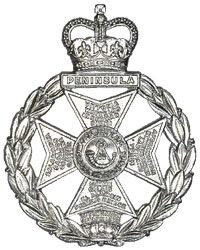Related Research Articles
The Infantry of the British Army comprises 49 infantry battalions, from 19 regiments. Of these, 33 battalions are part of the Regular army and the remaining 16 a part of the Army Reserve. The British Army's Infantry takes on a variety of roles, including armoured, mechanised, air assault and light.

The Royal Green Jackets (RGJ) was an infantry regiment of the British Army, one of two "large regiments" within the Light Division.

The Somerset Light Infantry (Prince Albert's) was a light infantry regiment of the British Army, which served under various titles from 1685 to 1959. In 1959, the regiment was amalgamated with the Duke of Cornwall's Light Infantry to form the Somerset and Cornwall Light Infantry which was again amalgamated, in 1968, with the King's Own Yorkshire Light Infantry, the King's Shropshire Light Infantry and the Durham Light Infantry to form The Light Infantry. In 2007, however, The Light Infantry was amalgamated further with the Devonshire and Dorset Regiment, the Royal Gloucestershire, Berkshire and Wiltshire Regiment and the Royal Green Jackets to form The Rifles.
The Rifles is an infantry regiment of the British Army. Formed in 2007, it consists of four Regular battalions and three Reserve battalions. Each Regular battalion of The Rifles was formerly an individual battalion of one of the two large regiments of the Light Division. Since formation the regiment has been involved in combat operations, first in the later stages of the Iraq War and in the War in Afghanistan.
The Lowland Brigade is a historical unit of the British Army which has been formed a number of times. It is traditionally Scottish as the name derives from the Scottish Lowlands.
The 1957 White Paper on Defence was a British white paper issued in March 1957 setting forth the perceived future of the British military. It had profound effects on all aspects of the defence industry but probably the most affected was the British aircraft industry. Duncan Sandys, the recently appointed Minister of Defence, produced the paper. The decisions were influenced by two major factors: the finances of the country and the coming of the missile age.
The Green Jackets Brigade was an administrative brigade of the British Army from 1946 to 1966 , that administered the English rifle regiments.
The Wessex Brigade was an administrative formation of the British Army from 1948 to 1968. The Brigade administered the regular infantry regiments of the Wessex area of south and south west England.
The Home Counties Brigade was an administrative formation of the British Army from 1948 to 1968. The Brigade administered the regular infantry regiments of the Home Counties of south east England.
The East Anglian Brigade was an administrative brigade of the British Army from 1946 to 1968, that administered the regiments with recruiting grounds in East Anglia, and the East of England.
The Forester Brigade was an administrative formation of the British Army from 1948 to 1964. The Brigade administered the regular infantry regiments of the English Midlands.
The Mercian Brigade was an administrative formation of the British Army from 1948 to 1964. The Brigade administered the infantry regiments from the area of England between the Trent, Mersey and Severn rivers that roughly corresponded to the ancient kingdom of Mercia.
The Welsh Brigade was an administrative formation of the British Army from 1948 to 1964. The Brigade administered the regular Welsh infantry regiments.
The Lancastrian Brigade was an administrative formation of the British Army from 1948 to 1968. The Brigade administered the regular infantry regiments of northwest England.
The Yorkshire Brigade was an administrative brigade formation of the British Army from 1948 to 1968. The brigade administered the regular infantry regiments of Yorkshire, England.
The North Irish Brigade was a Brigade of the British Army which existed between 1948 and 1968; it consisted of the three regiments from Northern Ireland. After the Second World War there were 14 infantry depots in the United Kingdom, each bearing a letter. The depots were territorially aligned, and Infantry Depot M at Omagh was aligned with the regiments from Northern Ireland.

The Duke of Cornwall's Light Infantry (DCLI) was a light infantry regiment of the British Army in existence from 1881 to 1959.
A large regiment is a multi-battalion infantry formation of the British Army. First formed in the 1960s, large regiments are the result of the amalgamation of a number of existing single-battalion regiments, and perpetuate the traditions of each of the predecessor units.

The Highland Brigade was an administrative brigade of the British Army from 1946 to 1968, that administered the regiments with recruiting grounds in the Scottish Highlands.
References
- ↑ Messenger, Charles (16 March 1994). A History of British Infantry: For Love of Regiment, Volume 2, 1915-1994. p. 156. ISBN 9780850524222.
- ↑ Whitaker's Almanack 1956, p. 471
- ↑ Merged regiments and new brigading - many famous units to lose separate identity, The Times, July 25, 1957
- ↑ Army Order 40/1959
- ↑ A L Kipling and H L King, Head-dress badges of the British Army, Volume 2, London, 1979
- ↑ "Infantry Brigade Depots (Location)". Parliamentary Debates (Hansard) . 7 March 1958. Retrieved 10 April 2014.
- ↑ Whitaker's Almanack 1969, p. 473